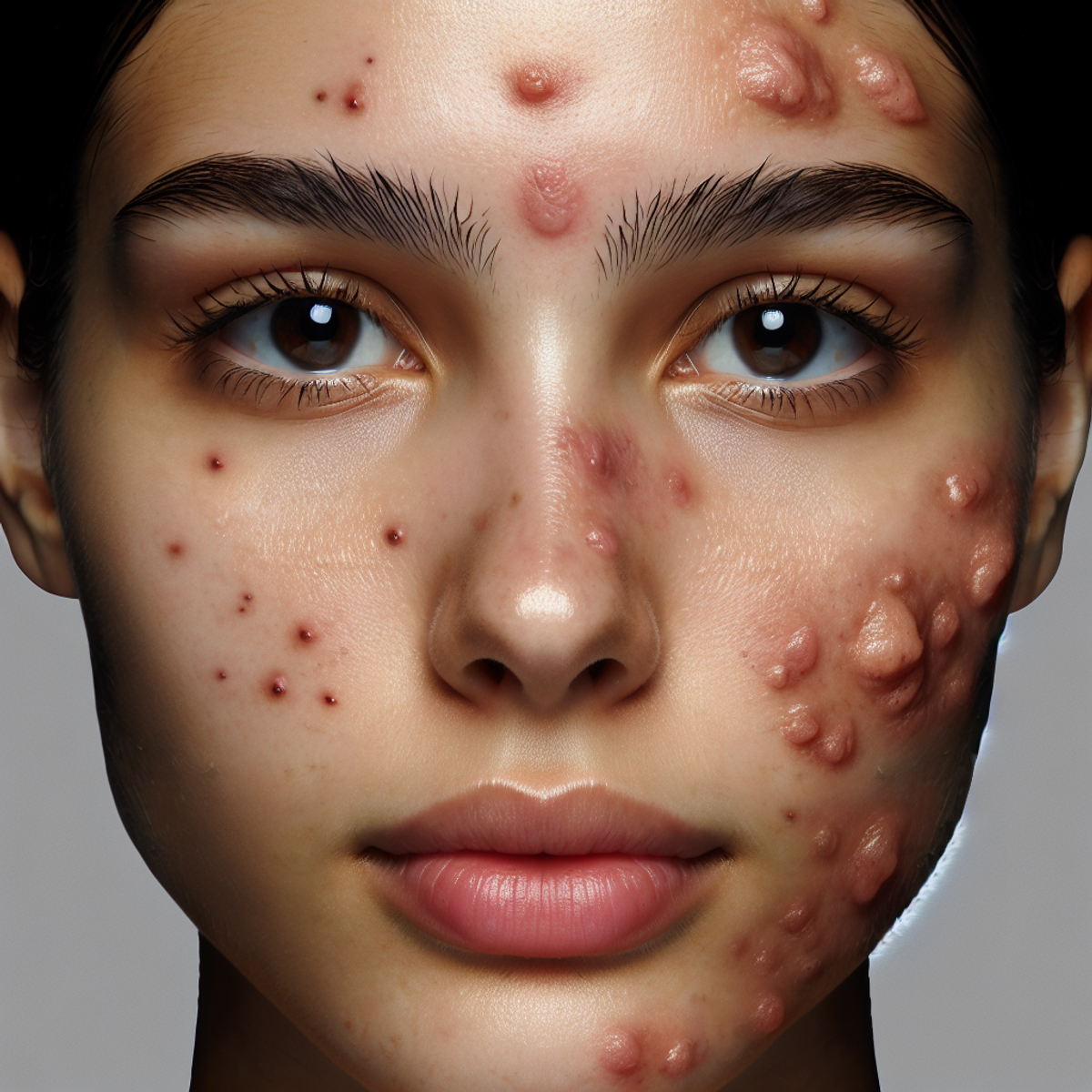How to Get Rid of Acne Scars—Forever

Introduction
Acne scars can be a constant reminder of past breakouts, affecting how we feel about ourselves and our confidence. These marks can have a big impact on how we see ourselves, making us really want to get rid of them for good. The emotional stress caused by acne scars often pushes people to look for treatments that actually work and give long-term results.
It’s important to understand what acne scars are and how they affect us deeply. There are different types of scars that acne can leave behind, such as:
- Atrophic scars: These create small dents or depressions in the skin.
- Hypertrophic scars: These cause raised tissue or bumps on the skin.
- Post-inflammatory hyperpigmentation (PIH): This is when dark spots or patches of discoloration appear after an acne breakout.
As we explore various remedies and treatments for acne scars, it becomes clear that we need a holistic approach to truly make a difference. By looking into all the different methods available, we can find ways to effectively reduce acne scars and support our journey towards having clear and healthy skin.
Understanding Different Types of Acne Scars
Acne scars can be a constant reminder of past breakouts, affecting self-esteem and confidence. Understanding the different types of acne scars is crucial in determining the most effective treatment options. Let’s explore the characteristics and causes of atrophic acne scars, the nature of hypertrophic acne scars, and the common issue of post-inflammatory hyperpigmentation (PIH) as a type of acne discoloration.
Atrophic Acne Scars
Atrophic acne scars are depressions or indentations in the skin caused by a loss of tissue. These scars are typically classified into three subtypes:
- Icepick Scars: These are deep, narrow scars that extend into the dermis. They resemble small, pointed holes on the skin surface and are often difficult to treat.
- Boxcar Scars: Boxcar scars have well-defined edges and appear as round or oval depressions with flat bottoms. They are wider than icepick scars and can vary in size.
- Rolling Scars: Rolling scars create a wave-like appearance on the skin due to tethering of underlying tissue. They are typically shallow and have a broad base.
Atrophic acne scars develop when there is insufficient collagen production during the healing process. This can occur as a result of severe inflammation, cystic acne, or delayed wound healing. The collagen fibers that support the skin’s structure become damaged or destroyed, leading to depressed areas on the skin’s surface.
Hypertrophic Acne Scars
In contrast to atrophic scars, hypertrophic acne scars involve an excess of collagen production during the healing process. These raised, thickened scars occur when the body produces too much collagen in response to inflammation or injury.
Hypertrophic acne scars usually remain within the boundaries of the original wound and may appear red or pink initially. Over time, they may become lighter in color but still remain elevated above the skin surface.
The formation of hypertrophic scars is often influenced by genetic factors. People with a family history of keloid or hypertrophic scarring are more prone to developing these types of acne scars.
Post-Inflammatory Hyperpigmentation (PIH)
Post-inflammatory hyperpigmentation (PIH) refers to the dark spots or patches that remain after an acne breakout has healed. These discolorations occur due to an increased production of melanin, the pigment responsible for skin coloration.
PIH is common among individuals with darker skin tones, as they naturally produce more melanin. It can take weeks or months for PIH to fade on its own, but certain treatments can help expedite the process.
Understanding the different types of acne scars—whether atrophic, hypertrophic, or discoloration-related—is essential in tailoring an effective treatment plan. By identifying the specific characteristics and causes of each type of scar, you can choose the most suitable approach to achieve smoother, clearer skin.
Natural Remedies and Home Treatments for Acne Scars
When it comes to treating acne scars, many people try natural remedies and home treatments hoping for long-term results. These methods often involve using ingredients like black seed oil, rosehip oil, and honey. While natural remedies may help, it’s important to know their limitations:
1. Mild Scars vs. Deep Scarring
Natural remedies like black seed oil, rosehip oil, and honey may be somewhat effective in improving mild acne scars. However, they are generally not as powerful for deep or severe scarring. It’s important to have realistic expectations about what these remedies can achieve.
2. Consistency and Patience
Getting noticeable results with natural treatments takes time and consistency. Unlike clinical procedures that often show more immediate changes, natural remedies may take longer to make a visible difference in the skin’s texture and appearance. So if you’re using these treatments, make sure to stick to a regular skincare routine and give them enough time to work.
While natural remedies can be used alongside other forms of acne scar treatment, it’s always a good idea to speak with a dermatologist or skincare professional before starting anything new. They can provide personalized advice based on your specific needs and guide you towards the most effective solutions.
“Natural remedies can be a gentle addition to your skincare routine, but they may not be enough on their own for significant scar improvement.”
Medical Procedures and Clinical Treatments for Acne Scars
When it comes to addressing acne scars, there are various medical procedures and clinical treatments that can significantly improve skin texture and reduce scarring. One popular option is the use of chemical peels, which work by removing the outer layer of skin to reveal smoother, less scarred skin underneath.
Chemical Peels
Chemical peels are a form of exfoliation that involves applying a chemical solution to the skin, causing it to blister and eventually peel off. This process stimulates the growth of new skin cells and can help improve the appearance of acne scars. There are different types of chemical peels that vary in strength and ingredients, each catering to different scar types and skin sensitivities.
Types of Chemical Peels for Acne Scars
- Glycolic Acid Peels: These peels use glycolic acid, a type of alpha hydroxy acid (AHA), to gently exfoliate the skin. They are effective in treating mild acne scars and can also improve overall skin texture and tone.
- TCA Peels (Trichloroacetic Acid): TCA peels are stronger than glycolic acid peels and penetrate deeper into the skin. They are often used to target moderate acne scars and pigmentation issues.
- Salicylic Acid Peels: Salicylic acid is a beta hydroxy acid (BHA) that is effective in treating acne scars, particularly those caused by clogged pores and inflammation. It also has anti-inflammatory properties that can help reduce redness and swelling associated with acne scars.
Chemical peels can be performed by dermatologists or licensed skincare professionals, and the frequency of treatments may vary depending on the severity of the scars. It’s important to note that while chemical peels can yield noticeable improvements in skin texture and tone, they may not completely eliminate deep or pitted acne scars. Additionally, individuals undergoing chemical peel treatments should be diligent about sun protection as the newly revealed skin will be more susceptible to UV damage.
Other Clinical Treatments for Acne Scars
In addition to chemical peels, there are other clinical treatments available for acne scars, including:
- Laser therapy: This treatment uses focused laser beams to target and break down scar tissue, stimulating collagen production and promoting the growth of new, smoother skin.
- Microneedling: Also known as collagen induction therapy, microneedling involves using tiny needles to create controlled micro-injuries in the skin. This process triggers the body’s natural healing response and can improve the appearance of acne scars.
- Injectable fillers: These fillers are used to temporarily plump up depressed acne scars, making them less noticeable. The results are immediate but not permanent, as the body gradually absorbs the filler over time.
Each option offers unique benefits and considerations based on individual scar types and treatment goals. It’s best to consult with a dermatologist or skincare professional at a [reputable cosmetic dermatology clinic](https://www.hopkinsmedicine.org/dermatology/specialty
2. Laser Treatment
Laser treatment is one of the most popular medical procedures for treating acne scars. It works by using high-intensity light beams to stimulate collagen production and remodel the skin, resulting in smoother and more even skin texture. Laser treatment can be highly effective for reducing the appearance of acne scars, especially for those with atrophic scars or uneven skin tone.
How Does Laser Treatment Work?
One advanced technique in laser treatment is fractional laser resurfacing. This method targets specific areas of the skin, allowing for precise scar revision. During the procedure, the laser creates tiny micro-columns of thermal injury in the skin, stimulating collagen production and promoting the growth of new, healthy skin cells. The damaged tissue is replaced with renewed skin, leading to a significant improvement in the appearance of acne scars.
Benefits of Fractional Laser Resurfacing
Fractional laser resurfacing offers several benefits over traditional laser treatments:
- Minimizes downtime and discomfort while providing noticeable results
- Allows for more targeted treatment, making it suitable for individuals with specific scar types or areas of concern
Important Considerations
It is important to note that laser treatment for acne scars should only be performed by a qualified dermatologist or skincare professional. They will assess your skin condition and determine the most appropriate type of laser therapy for your specific needs. The number of sessions required will depend on the severity of your scars and how your skin responds to the treatment.
Potential Side Effects
While laser treatment can be highly effective, it is not without potential side effects:
- Temporary redness, swelling, or mild discomfort immediately after the procedure
- These effects typically subside within a few days
At-Home Laser Devices
In addition to professional laser treatments, there are also at-home devices available that use low-level laser therapy (LLLT) to target acne scars. These devices are designed to provide milder treatments compared to clinical lasers but may still offer some benefits in improving scar appearance. However, it’s important to consult with a dermatologist before using any at-home laser devices to ensure they are safe and suitable for your specific condition.
Combination Therapy for Optimal Results
Combining laser treatment with other acne scar treatments, such as chemical peels or microneedling, can further enhance the results. This comprehensive approach addresses different aspects of scar formation and promotes overall skin rejuvenation.
3. Microneedling
Microneedling is another popular medical treatment for acne scars that dermatologists recommend. This procedure involves using a device with tiny needles to create controlled micro-injuries on the skin’s surface. The purpose of these micro-injuries is to stimulate collagen production and promote scar remodeling.
Here are some key points to understand about microneedling:
- Promotes Scar Remodeling: Microneedling works by creating small punctures in the skin, which triggers the body’s natural healing response. As the skin repairs itself, new collagen is produced, helping to improve the appearance of acne scars over time. This process of scar remodeling can lead to smoother and more even-looking skin.
- Dermarollers as At-Home Tools: Dermarollers are handheld devices with small needles that can be used at home for microneedling. They are designed to safely and effectively stimulate collagen production in the skin. However, it’s important to note that while dermarollers can be convenient for some individuals, they may not be suitable for everyone or every type of acne scar. It’s always best to consult with a dermatologist before attempting at-home microneedling.
Cautionary Note: It’s essential to follow proper hygiene practices when using dermarollers at home. Make sure to clean the device thoroughly before and after each use, and avoid sharing it with others to reduce the risk of infection.
Microneedling is considered a safe and effective treatment option for certain types of acne scars. However, it may not provide significant improvement for deep or severe scarring. In such cases, your dermatologist may recommend alternative procedures like laser resurfacing or chemical peels.
Remember, consistency is key when undergoing any acne scar treatment. Results from microneedling may take time, and multiple sessions might be necessary to achieve optimal outcomes. It’s important to follow your dermatologist’s recommendations and attend all scheduled appointments.
By combining microneedling with other treatments, such as chemical peels or laser therapy, you can maximize the potential for scar improvement. Your dermatologist will be able to assess your specific needs and create a personalized treatment plan that addresses your unique acne scars.
Overall, microneedling is a valuable medical procedure for addressing acne scars. Whether performed by a professional or done at home with caution, this treatment option can contribute to smoother, more even-toned skin over time. Consult with a dermatologist to determine if microneedling is the right choice for you and your specific acne scars.
If you are in England, it’s worth noting that there are ongoing discussions regarding the licensing of non-surgical cosmetic procedures. These discussions aim to ensure safety and quality standards are met in such procedures. Additionally, in Wisconsin, there are specific regulations in place for cosmetic procedures to protect consumer interests and maintain industry standards.
4. Injections
When it comes to medical treatments for acne scars, dermatologists often recommend injectable treatments for certain types of raised scars. These treatments involve the use of corticosteroids or collagen-stimulating injections to help improve the appearance of acne scars.
Corticosteroid Injections
Corticosteroids are anti-inflammatory medications that can be injected directly into raised acne scars. These injections work by reducing inflammation and flattening the scar tissue. Dermatologists typically administer corticosteroid injections every few weeks until the desired results are achieved. This treatment is particularly effective for hypertrophic and keloid scars, which are raised and often red in color.
Collagen-Stimulating Injections
Another option for treating certain types of acne scars is collagen-stimulating injections. These injections encourage the production of collagen, a protein that helps improve skin texture and plump up depressed scars. One common type of collagen-stimulating injection is made with poly-l-lactic acid (PLLA), which gradually stimulates collagen production over time. This treatment is often recommended for atrophic acne scars, which are characterized by sunken or depressed areas on the skin.
It’s important to note that while these injectable treatments can be effective for specific types of acne scars, they may not be suitable for everyone. It’s essential to consult with a qualified dermatologist or skin specialist who can evaluate your unique situation and recommend the most appropriate treatment options.
In addition to injectable treatments, there are various other medical procedures and clinical treatments available for acne scars, including:
- Chemical peels
- Laser treatment
- Microneedling
Each of these procedures targets different aspects of acne scarring and can provide significant improvements in skin texture and appearance.
By exploring various medical procedures and clinical treatments, you can find a solution that suits your specific needs and helps you achieve long-lasting results in your quest to get rid of acne scars forever.
Remember, it’s crucial to consult with a dermatologist or skin specialist who can assess your individual situation and recommend the most suitable treatment options for your specific type of acne scars. They can guide you through the process and ensure you receive the best possible care for your skin.
Combining Treatments: A Holistic Approach to Treating Acne Scars
When it comes to treating acne scars, taking a holistic approach can yield the best results. A comprehensive skincare routine, along with targeted treatments, can support scar healing and improve the overall appearance of your skin. Here are some key points to consider when combining treatments for acne scars:
1. A Comprehensive Skincare Routine
Building a skincare routine specifically tailored for acne scars can help optimize treatment outcomes. Incorporating the right ingredients and products can promote scar healing and improve the texture and tone of your skin. Some important considerations include:
- Salicylic Acid: This beta hydroxy acid (BHA) helps exfoliate the skin, unclog pores, and reduce inflammation. It can be particularly effective in treating atrophic acne scars by promoting cell turnover and stimulating collagen production.
- Retinoids: These vitamin A derivatives are known for their ability to increase cell turnover, fade discoloration, and stimulate collagen production. Regular use of retinoids can help improve the appearance of both atrophic and hypertrophic acne scars.
- Alpha Hydroxy Acids (AHAs): AHAs like glycolic acid and lactic acid can help exfoliate the skin’s surface, improve texture, and fade acne discoloration. They also promote collagen production for smoother-looking skin.
2. Guidelines for Using Key Ingredients
While incorporating key ingredients in your skincare routine is beneficial, it’s important to use them properly to avoid any potential side effects or irritation. Here are some guidelines to keep in mind:
- Start with a low concentration of active ingredients and gradually increase as your skin tolerates it.
- Follow product instructions carefully and avoid overusing or layering multiple active ingredients at once.
- Use sunscreen daily to protect your skin from UV damage, which can worsen acne scars and cause further discoloration.
Remember, consistency is key when it comes to seeing results from your skincare routine. Stick to your regimen and be patient as it can take time for improvements to become noticeable.
By combining targeted treatments with a comprehensive skincare routine, you can enhance the effectiveness of each individual treatment and achieve better overall results in your quest to get rid of acne scars. Don’t be afraid to consult with a dermatologist or skincare professional who can provide personalized advice based on your specific skin type and scar concerns.
Maximizing Results: Sun Protection and Lifestyle Habits
When it comes to treating acne scars, it’s not just about the treatments you use, but also about taking care of your skin and overall well-being. In this section, we will discuss the importance of sun protection and adopting healthy lifestyle habits to maximize the results of your acne scar treatment.
Sun Protection for Acne Scars
Sunscreen is a crucial component in any skincare routine, but it becomes even more important when you are dealing with acne scars. Here’s why:
- Preventing further discoloration: Exposure to the sun’s harmful UV rays can cause hyperpigmentation and make your acne scars more noticeable. By using sunscreen daily, you can help prevent this discoloration and protect your healing scars.
- Protecting against damage: The sun can also damage your skin and hinder the healing process of your acne scars. Sunburns or excessive sun exposure can lead to inflammation, which can delay scar healing. Applying sunscreen with a high SPF will create a barrier between your skin and the sun, allowing it to heal properly.
When choosing a sunscreen for acne scars, opt for one that offers broad-spectrum protection (protects against UVA and UVB rays) and has an SPF of 30 or higher. Look for non-comedogenic formulas that won’t clog your pores.
Healthy Diet for Scar Healing
Maintaining a healthy diet plays a significant role in promoting overall skin health and scar healing. Here are some tips to consider:
- Eat a balanced diet: Include plenty of fruits, vegetables, whole grains, lean proteins, and healthy fats in your meals. These nutrient-rich foods provide essential vitamins and minerals that support skin regeneration.
- Stay hydrated: Drinking an adequate amount of water helps keep your skin hydrated from within, improving its elasticity and promoting scar healing.
- Avoid inflammatory foods: Some foods can trigger inflammation in the body, which can exacerbate acne and slow down scar healing. Limit your intake of processed foods, sugary snacks, and greasy foods.
Stress Management for Scar Healing
Stress can have a negative impact on your skin’s health and the healing process of acne scars. Consider incorporating stress management techniques into your daily routine:
- Practice relaxation techniques: Engage in activities such as meditation, deep breathing exercises, or yoga to reduce stress levels and promote overall well-being.
- Get enough sleep: Aim for 7-9 hours of quality sleep each night. Sufficient rest allows your body to repair and regenerate damaged skin cells.
- Engage in physical activity: Regular exercise not only reduces stress but also improves blood circulation, which is essential for delivering oxygen and nutrients to the skin.
By prioritizing sun protection, maintaining a healthy diet, and managing stress levels, you can create an environment that supports the healing of your acne scars. Remember that these lifestyle habits should be complemented by a comprehensive skincare routine and appropriate treatments for optimal results.
When to Seek Professional Help: Choosing a Dermatologist for Acne Scar Treatment
When it comes to addressing acne scars, consulting with a qualified dermatologist or skin specialist is crucial for personalized treatment advice. While some home remedies and over-the-counter products may provide relief for mild scarring, professional guidance can make a significant difference, especially for moderate to severe acne scars. Here are some key points to consider when seeking professional help for treating acne scars:
- Expert Evaluation: A dermatologist or acne scar specialist can accurately assess the type and severity of your acne scars, determining the most suitable treatment options based on your specific skin condition.
- Customized Treatment Plans: Unlike generic solutions, a dermatologist can create a tailored treatment plan that addresses your unique scar concerns, taking into account factors such as skin type, medical history, and previous treatments.
- Access to Advanced Procedures: Dermatologists can offer advanced clinical treatments such as laser therapy, chemical peels, microneedling, and injectable fillers that may not be available or safe for at-home use.
- Professional Oversight: Under the care of a dermatologist, you’ll receive ongoing monitoring and support throughout your scar treatment journey. This ensures that any adjustments or additional interventions can be made as needed.
- Quality Product Recommendations: Dermatologists can recommend medical-grade skincare products containing potent ingredients like retinoids, hydroxy acids, and prescription-strength formulations that are proven to improve skin texture and tone.
- Post-Treatment Care: Following professional procedures or treatments, dermatologists can provide detailed post-care instructions to optimize healing and minimize potential side effects.
By seeking professional help from a qualified dermatologist or acne scar specialist, individuals can gain access to specialized expertise and resources that significantly enhance the effectiveness of their acne scar treatment efforts. Remember that every individual’s skin is unique, and professional guidance plays a pivotal role in achieving successful outcomes in scar management.
Conclusion
When it comes to getting rid of acne scars permanently, the journey may involve trying out different treatments and remedies. It’s essential to explore suitable options and stay consistent in your chosen path to achieve clear skin.
Embracing self-acceptance and confidence throughout the scar healing journey is crucial. Remember that everyone’s skin is unique, and the healing process may take time. Stay patient and be kind to yourself as you work towards achieving your skincare goals.
As you continue on your path to clear skin, remember that seeking professional advice from a dermatologist or skin specialist can provide personalized guidance tailored to your specific needs. By combining professional expertise with a holistic approach to skincare, you can maximize the effectiveness of your chosen treatments and embrace a positive mindset throughout the journey towards smoother, healthier-looking skin.










